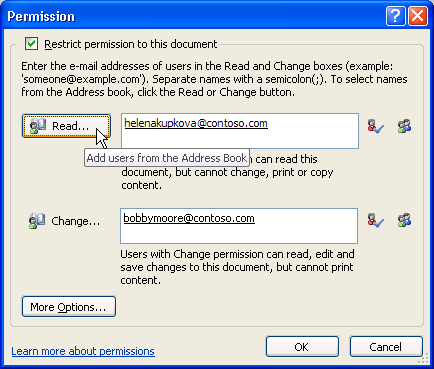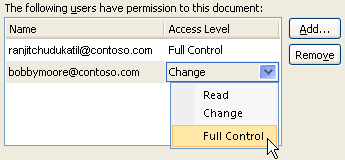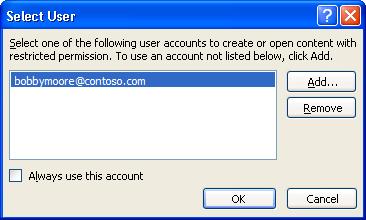Configure your computer to use IRM
To use IRM in Office, the minimum required software is Windows Rights Management Services (RMS) Client Service Pack 1 (SP1). The RMS administrator can configure company-specific IRM policies that define who can access information and what level of editing is permitted for an e-mail message. For example, a company administrator might define a rights template called "Company Confidential," which specifies that an e-mail message that uses that policy can be opened only by users inside the company domain.
Download permissions
The first time that you try to open a document, workbook, or presentation with restricted permission, you must connect to a licensing server to verify your credentials and to download a use license. The use license defines the level of access that you have to a file. This process is required for each file that has restricted permission. In other words, content with restricted permission cannot be opened without a use license. Downloading permissions requires that Office send your credentials, which includes your e-mail address, and information about your permission rights to the licensing server. Information contained in the document, workbook, or presentation is not sent to the licensing server. For more information, read the Privacy Statement Highlights for Microsoft Office 2010.
Restrict permission to content in files
Authors can restrict permission for documents, workbooks, and presentations on a per-user, per-file, or per-group basis (group-based permissions require Active Directory directory service for group expansion). Authors use the Permission dialog box to give users Read and Change access, and to set expiration dates for content. For example, Ranjit, the author, can give Helena permission to read a Word document but not change it. Ranjit can then give Bobby permission to change the document and allow him to save the document. Ranjit might also decide to limit both Helena's and Bobby's access to this document for five days before the permission to the document expires. For information about how to set an expiration date for a document, workbook, or presentation, see Set an expiration date for a file.

-
Save the document, workbook, or presentation.
-
Click the File tab.
-
Do one of the following:
-
In Word, on the Info tab, click Protect Document, point to Restrict Permission by People, and then click Restricted Access.
-
In Excel, on the Info tab, click Protect Workbook, point to Restrict Permission by People, and then click Restricted Access.
-
In PowerPoint, on the Info tab, click Protect Presentation, point to Restrict Permission by People, and then click Restricted Access.
-
In the Permissions dialog box, do one of the following:
-
In Word, select Restrict permission to this document, and then assign the access levels that you want for each user.
-
In Excel, select Restrict permission to this workbook, and then assign the access levels that you want for each user.
-
In PowerPoint, select Restrict permission to this presentation, and then assign the access levels that you want for each user.
Your choices might be limited if an administrator has set custom permission policies that individuals cannot change.
Permission levels
-
Read Users with Read permission can read a document, workbook, or presentation, but they don't have permission to edit, print, or copy it.
-
Change Users with Change permission can read, edit, and save changes to a document, workbook, or presentation, but they don't have permission to print it.
-
Full Control Users with Full Control permission have full authoring permissions and can do anything with the document, workbook, or presentation that an author can do, such as set expiration dates for content, prevent printing, and give permissions to users. After permission for a document, workbook, or presentation has expired for authorized users, the document, workbook, or presentation can be opened only by the author or by users with Full Control permission to the document, workbook, or presentation. Authors always have Full Control permission.
-
To give someone Full Control permission, in the Permissions dialog box, click More Options, and then in the Access Level column, click the arrow, and then click Full Control in the Access Level list.

-
After you assign permission levels, click OK.
The Message Bar appears, which indicates that the document, workbook, or presentation is rights-managed. If you must make any access permission changes to the document, workbook, or presentation, click Change Permission.

If a document, workbook, or presentation that has restricted permission is forwarded to an unauthorized person, a message appears with the author's e-mail address or Web site address so that the individual can request permission for the document, workbook, or presentation.

If the author chooses not to include an e-mail address, unauthorized users get an error message.
Set an expiration date for a file
-
Open the file.
-
Click the File tab
-
Do one of the following:
-
In Word, on the Info tab, click Protect Document, point to Restrict Permission by People, and then click Restricted Access.
-
In Excel, on the Info tab, click Protect Workbook, point to Restrict Permission by People, and then click Restricted Access.
-
In PowerPoint, on the Info tab, click Protect Presentation, point to Restrict Permission by People, and then click Restricted Access.
-
In the Permissions dialog box, do one of the following:
-
In Word, select the Restrict permission to this document check box, and then click More Options.
-
In Excel, select the Restrict permission to this workbook check box, and then click More Options.
-
In PowerPoint, select the Restrict permission to this presentation check box, and then click More Options.
-
Under Additional permissions for users, do one of the following:
-
In Word, select the This document expires on check box, and then enter a date.
-
In Excel, select the This workbook expires on check box, and then enter a date.
-
In PowerPoint, select the This presentation expires on check box, and then enter a date.
-
Click OK twice.
Use a different Windows user account to rights-manage files
-
Open the document, worksheet, or presentation.
-
Click the File tab.
-
Do one of the following:
-
In Word, on the Info tab, click Protect Document, point to Restrict Permission by People, and then click Manage Credentials.
-
In Excel, on the Info tab, click Protect Workbook, point to Restrict Permission by People, and then click Manage Credentials.
-
In PowerPoint, on the Info tab, click Protect Presentation, point to Restrict Permission by People, and then click Manage Credentials.
-
Do one of the following:
-
In the Select User dialog box, select the e-mail address for the account that you want to use, and then click OK.
-
In the Select User dialog box, click Add, type your credentials for the new account, and then click OKtwice.

View content with restricted permission
To view rights-managed content that you have permissions to by using Office, just open the document, workbook, or presentation.
If you want to view the permissions you have, either click View Permission in the Message Bar or click one of the following in the status bar at the bottom of the screen:
-
This document contains a permissions policy 
-
This workbook contains a permissions policy 
-
This presentation contains a permissions policy 